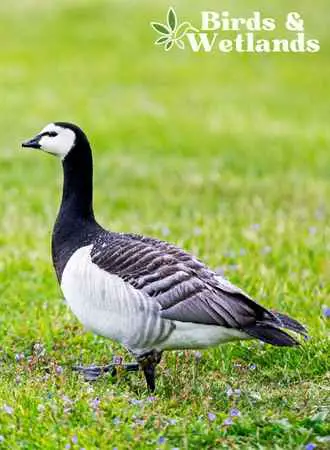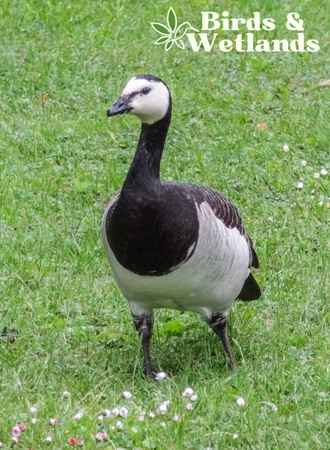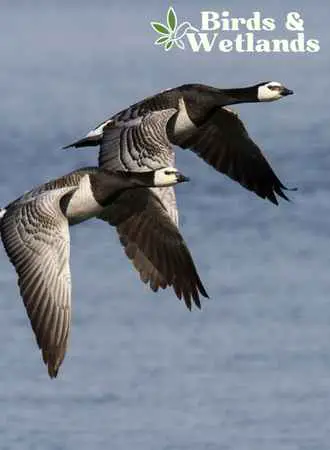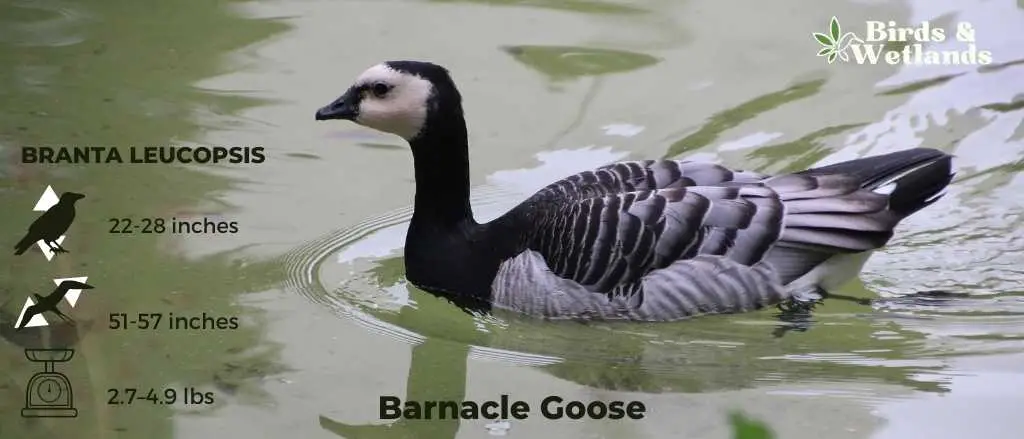The barnacle goose is a species of goose that is known for its distinctive plumage, rounded head and small size. This remarkable bird belongs to the genus Branta, which contains several other black geese species, including the brant goose. Made up of eastern lineages, the lineage of the barnacle goose originated in the cackling goose.
Scientific Name: Branta leucopsis
Height: 55–70 cm (22–28 in)
Wingspan: 130–145 cm (51–57 in)
Weight: 1.21–2.23 kg (2.7–4.9 lb)
Barnacle Goose Description
The barnacle goose is a medium-sized waterfowl with black and white plumage and large webbed feet. As an adult, this goose has a distinctive black crown, neck, breast, and completely barred gray upper parts. The unusual combination of features makes it easy to identify this bird from afar.
Other distinct markings include white rump sides, upper tail coverts, and a rounded black tail. Additionally, the barnacle goose has black wing feathers with a pale gray inner web, white scapulars, and gray wing coverts with black and white tips.
The underparts of the barnacle goose are slightly barred in shades of gray, which is much paler than the rest of its body. Notably, the barnacle goose also boasts white underwing coverts that blend in seamlessly with the white sides of its rump to create a striking contrast against its otherwise dark body.
Furthermore, the head of the barnacle goose is characterized by a combination of dark coloring on the bill base, lores, and eye area and light coloring around the eyes themselves. In fact, only the black upper crown and nape stand out against an otherwise white or buffy-white head.
Males and females share the same plumage, but males are slightly larger than females.

Listen to Barnacle Goose
Barnacle Goose Habitat
The Barnacle Goose is an arctic species that inhabits coastal tundra, breeding in the high Arctic on cliffs, crags, and rocky outcrops. These birds prefer to nest in areas near water, such as rivers, salt marshes, coastal regions, streams, lakes, ponds, and small islands.
During the summer, these geese forage in wet meadows, grassy fields, muddy flats, and other damp habitats, feeding on plants such as aquatic grasses and sedges.

Barnacle Goose Diet
Barnacle geese are omnivorous creatures but they primarily feed on plant material such as grass, stems, leaves, aquatic vegetation, and agricultural crops.
During the breeding season in the tundra, these geese feed on a wide variety of plants to meet their nutritional needs. In addition to these greens, barnacle geese eat grasses, herbs, grain, and sugar beets during autumn and winter. It is pretty rare to see these birds eating meat but they may occasionally feed on insects and small fish.

Barnacle Goose Range

Barnacle geese are migratory birds that breed in Greenland, the Arctic islands and northern Eurasia, spending the winter months in their wintering ranges in northwestern Europe and the British Isles. Breeding populations of Svalbard winter in Solway Firth on the west coast of England while the population derived from Novaya Zemlya population winter in the Baltic Sea, Netherlands and Germany.
Due to their widespread distribution and seemingly random vagrancy patterns, accurately assessing these birds’ population distribution is difficult. However, it is believed that barnacle geese are a relatively rare sight in the northeastern United States, with many records of sightings potentially resulting from escaped captive birds rather than a natural occurrence of wild birds. Most vagrant barnacle geese in North America are always sighted with the Canada goose.
During their winter migration, you can a flock of these geese in V-formation.
Barnacle Goose Nesting & Mating
Most barnacle geese prefer building nests in high, inaccessible locations on cliff edges to avoid predators. Because these areas are typically far away from their feeding grounds, such as lakes and rivers, these feral birds are relatively free from the threat of predators like arctic foxes and polar bears. The nest is lined with down and made of dead foliage and mud.
The female lays 3 to 5 eggs and incubates for 24 to 26 days. After hatching, goslings are born with feathery down and are very light weight helps to protect them from serious injury.
Like most geese, barnacle Geese are monogamous and form life-long pair bonds and fidelity to their mates. Once paired up, these geese generally stay together for the duration of their lives, only separating if one dies or becomes sick. These geese typically live in family groups and large flocks with other geese.

Barnacle Goose Population & Conservation
The entire population of barnacle goose is considered fully protected throughout its global range, as adults, eggs, and the down from these geese were once heavily exploited by humans. One potential threat to these birds’ population is persecution by farmers, who may see them as a nuisance when they graze in pastures used for grazing livestock.
However, despite these challenges, the current conservation status of the Barnacle Goose has been assessed as Least Concern. This means that it is believed that this species is not currently facing any significant threats that could cause populations to decline in the near future. Whether or not this status will change in the future remains to be seen.

Key Takeaways
Males and females share the same plumage but males are slightly larger than females.
Barnacle geese breed in remote Arctic regions, northern Europe and northern Russia. They have separate breeding and wintering grounds.
The barnacle goose’s natural history was long surrounded by a legend claiming that they were born of driftwood.
The barnacle goose is a medium-sized waterfowl with a black head and upper breast, silver-gray underwing linings, white belly, black neck, creamy-white face and white plumage and large webbed feet.
The wings and back are silver-gray with black-and-white bars that shine when light reflects off of them.
Barnacles are monogamous.


